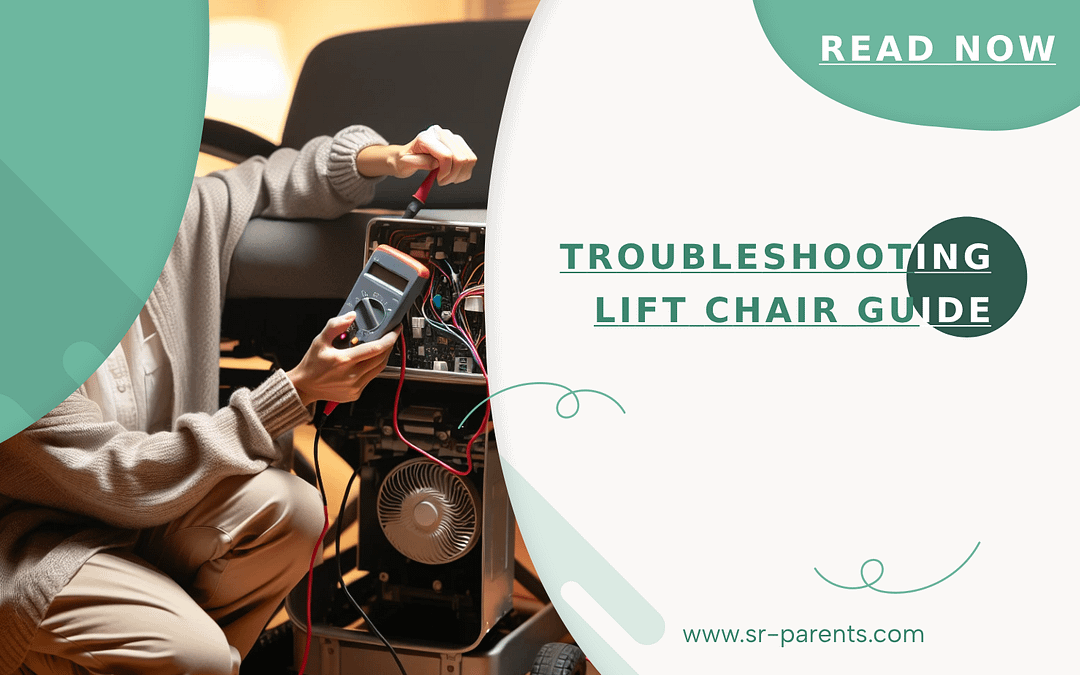Have you ever felt the frustration of a malfunctioning lift chair? These chairs can sometimes leave us puzzled when they stop working. But don’t worry! In this guide, we’ll explore troubleshooting a lift chair, focusing on lift chair maintenance and notice signs. You’ll learn quick fixes and expert tips to get your chair back in action. Keep reading and discover how simple solving lift chair glitches can be.
Contents
Essential Troubleshooting Lift Chair Guide: Fix Common Issues Quickly
Lift chairs, or power recliners, are essential for many individuals who require assistance transitioning from seated to standing. They provide comfort, independence, and a sense of security. However, like any other piece of furniture, lift chairs can experience issues that require attention.
This blog post aims to provide essential troubleshooting lift chair tips, preventive maintenance advice, and guidance on when to seek professional help, ensuring that you can enjoy your lift chair for years to come.
Key Takeaways
- Identify common lift chair problems and address them promptly.
- Consult the manufacturer or a professional for complex repairs, safety concerns, and warranty coverage.
- Be aware of potential risks when attempting DIY repairs to avoid costly replacements.
Identifying Lift Chair Problems
Among the most common lift chair problems are:
- Motor issues
- Power supply problems
- Abnormal sounds
- Malfunctioning remote controls
Recognizing these issues early on and taking appropriate action can help prevent further damage and maintain the chair’s functionality.
The upcoming sections will detail these issues and guide you through steps to resolve them.
Motor Issues
Lift chair motors are prone to malfunction, particularly in new lift chairs. Signs that your lift chair motor may be experiencing issues include no response when the remote is pressed, no operation even when plugged into the wall outlet, and broken or damaged wires near the motor. Determining the need for a replacement motor is paramount when dealing with motor issues.
Initiating a lift chair motor replacement involves the following steps:
- Unplug the chair and remove any cushions or covers.
- Unscrew or unbolt the motor from the chair frame and disconnect any wires or cables.
- Obtain the correct replacement motor.
- Connect the wires or cables to the new motor.
- Secure the new motor to the chair frame.
- Reinstall the cushions or covers.
- Plug the chair back in to test the motor.
Remember to consult the manufacturer or professional repair service if you’re unsure about replacing the motor yourself.
Power Supply Problems
Power supply glitches can often be the root cause of a lift chair not functioning correctly. Taking corrective measures at the earliest can help avoid further damage and inconvenience.
Factors that contribute to power supply problems include electrical surges, mechanical malfunctions, and depleted batteries. To address these issues, first, ensure that the lift chair is plugged into a functioning outlet and that the power switch is in the “on” position.
If the lift chair still doesn’t work, consider the following steps:
- Replace the batteries in the remote control or order a new remote.
- Perform a biannual replacement of batteries in the lift chair.
- Consult the owner’s manual for troubleshooting tips.
- Contact a professional repair service for further assistance if needed.
Abnormal Sounds
Aging parts or damage in your lift chair can manifest as abnormal sounds like creaking or grinding. Clean any rust from the chair’s components using a wire brush and lubricate the parts with oil to address these issues. Additionally, inspect the chair for any bent, loose, or damaged components, as these issues may generate abnormal sounds when damaged or worn out.
Should you struggle to identify the source of abnormal sounds or have concerns about safety risks, a professional inspection of the lift chair is recommended. They can determine the source of the problem and recommend appropriate solutions to ensure your lift chair remains safe and functional.
Malfunctioning Remote Controls
Remote controls are essential for operating lift chairs but can become inoperable due to extended daily use or depleted batteries. If your lift chair remote stops working, check if the batteries need replacement. If replacing the batteries doesn’t resolve the issue, consider ordering a new remote if you have an extended protection plan.
It’s important to use the correct batteries for your remote control and to replace them regularly to ensure optimal performance. These steps can help circumvent remote control issues, ensuring your lift chair functions optimally.
Preventive Maintenance for Lift Chairs
Preventive maintenance is essential for preserving the upholstery or leather of your lift chair and ensuring its optimal functioning. Regular cleaning, checking wiring connections, and avoiding exposure to heat and sunlight can help prevent common issues such as power supply problems, motor malfunctions, and abnormal sounds.
The forthcoming sections will render efficient maintenance tips and advice for your lift chair.
Regular Cleaning
Regular cleaning is crucial for maintaining the appearance and functionality of your lift chair. Here are some tips to keep in mind:
- Utilize mild fabric cleaners specifically designed for the material of the chair, and avoid harsh chemicals or bleach-based cleaners.
- For leather lift chairs, a damp cloth is sufficient.
- Be sure to keep the cleaning solution away from the chair’s electronics.
Additionally, regularly vacuum or wipe down the motor, hand control, and power cord to prevent dust buildup. Consistent cleaning not only extends the lifespan of your lift chair but also preserves its appearance, improves hygiene, and increases comfort.
Check Wiring Connections
Inspecting the wiring connections of your lift chair regularly is essential to ensure they are connected properly, guaranteeing smooth operation and safety. Here are some steps to follow:
- Examine the connections for any loose or disconnected wires.
- Confirm that all connections are secure and suitably insulated.
- Additionally, inspect all wiring harnesses to ensure they are not frayed, damaged, or exhibiting signs of corrosion.
Frequent checks of wiring connections can preempt power supply and wire cut issues common in lift chairs. By identifying potential issues early on and addressing them promptly, you can ensure your lift chair is consistently receiving power and avoid further damage or malfunction.
Avoid Exposure to Heat and Sunlight
Exposure to heat and sunlight can cause fading, discoloration, and deterioration of lift chair fabric. To protect your lift chair, position it away from direct sunlight or heat sources such as space heaters or lit tobacco products. Additionally, consider using protective covers or coatings specifically designed for lift chairs to extend their lifespan and prevent damage from heat and sunlight exposure.
Adopting these precautions can preserve the look and function of your lift chair, ensuring its value in your daily life in the years to come.
When to Seek Professional Help
There are times when professional help is necessary for troubleshooting and repairing a lift chair, such as when the chair is covered under warranty, complex repairs are required, or there are safety concerns.
The upcoming sections will delve deeper into these situations, providing guidance on when to engage professional assistance.
Warranty Coverage
Warranty coverage can be a lifesaver when it comes to lift chair repairs and troubleshooting, as it may include repairs or replacements for chair components. However, DIY repairs on a lift chair can void the warranty, leading to costly repairs or replacements. It’s essential to consult the manufacturer or a professional for any repairs to maintain your warranty coverage.
Should your lift chair under warranty encounter issues, reach out to the manufacturer or retailer for further assistance. They can help address common problems. If the chair is still covered, there may be protection for damages or broken parts.
Complex Repairs
Some lift chair repairs are too complex for DIY solutions and should be handled by professionals to ensure safety and functionality. Examples of complex repairs include:
- Servicing electronic components such as hand controls, power transformers, and lift motors
- Inspecting and repairing damaged cables
- Addressing issues with the chair’s mechanism
It is important to seek professional help for these types of repairs.
Attempting complex repairs and troubleshooting without professional assistance can result in further damage to the lift chair or even personal injury. For complex repairs, seeking professional help is the safest approach to avoid these risks.
Safety Concerns
Professionals should always address safety concerns to prevent accidents or further damage to the lift chair. Examples of safety concerns include electrical hazards, structural instability, and improper installation.
Ignoring safety precautions during DIY repairs can result in accidents or injuries. Given safety concerns, consulting a professional is crucial to guarantee the safety of both the lift chair and its user.
Choosing the Right Lift Chair for Your Needs
Selecting the right lift chair is essential for ensuring comfort, functionality, and satisfaction. Factors to consider when choosing a lift chair include body type compatibility, features and functionality, and budget considerations.
The subsequent sections will offer guidance on selecting the lift chair that best suits your needs.
Body Type Compatibility
Body type compatibility is crucial for ensuring that a lift chair provides proper support and comfort. When selecting a lift chair, consider factors such as:
- Seat width
- Seat depth
- Seat height
- Backrest height
- Backrest width
These factors will guarantee a comfortable fit in your desired position.
A sit test, aided by a design consultant, can confirm the suitability of a lift chair to your body type. This test ensures:
- Your legs can touch the floor
- Your head should be positioned correctly on the back seat
- Recliners allow you to check how far out the leg rest extends and where your feet will be placed
- Make sure that your feet can still remain on the ground when you are elevated.
Features and Functionality
Lift chairs offer a variety of features and functionalities to improve user comfort and convenience. Examples include:
- Reclining functionality
- Heat and massage functions
- Leg elevation
- Lateral supports
- Lift function
Consider how these features can enhance your sitting experience when selecting a new lift chair, such as a power recliner.
Choosing a lift chair with features and functionality that align with your needs and preferences is crucial. By carefully considering your individual requirements, you can find a lift chair that perfectly balances comfort, functionality, and convenience.
Budget Considerations
Budget considerations play a significant role in determining the best lift chair option within your financial means. Lift chairs can range in cost from $600 to over $1,000, depending on the type and additional features.
When choosing a lift chair, consider your budget and explore financing options such as Medicare, Medicaid, private insurance, veteran’s benefits, and financing programs offered by lift chair retailers. Considering these factors allows you to find a lift chair that meets your needs without overstretching your budget.
DIY Lift Chair Repairs: What to Avoid
While DIY lift chair repairs can save you money and time, there are certain things to avoid, such as voiding the warranty, using incompatible replacement parts, and ignoring safety precautions.
The subsequent sections will outline these pitfalls and offer guidance on circumventing them.
Voiding the Warranty
Attempting DIY repairs on a lift chair can void the warranty, which can lead to costly repairs or replacements. To maintain your warranty coverage, it’s essential to consult the manufacturer or a professional for any repairs.
Engaging professional help for lift chair repairs helps keep the warranty intact, ensuring coverage for any future issues. This can save you money and provide peace of mind.
Using Incompatible Replacement Parts
Using incompatible replacement parts for lift chairs can cause further damage or compromise the chair’s safety and functionality. It’s important to use compatible parts recommended by the manufacturer to ensure the proper operation of your lift chair.
Consulting the manufacturer or professional repair service for guidance on the right parts for your lift chair helps to avoid risks associated with using incompatible replacements. This will help ensure your lift chair remains safe and functional.
Ignoring Safety Precautions
Ignoring safety precautions during DIY lift chair repairs can result in accidents or injuries. To ensure your safety and the proper functioning of your lift chair, it’s important to adhere to the manufacturer’s instructions and guidelines when performing DIY repairs.
Use safety equipment like:
- goggles
- work gloves
- non-slip shoes
- dust masks or respirators
And keep a first aid kit handy when conducting DIY lift chair repairs. By prioritizing safety, you can prevent accidents and maintain the quality of your lift chair.
Video By: @juga7
Wrapping It Up
Learning about troubleshooting and maintaining your lift chair can ensure its optimal performance and longevity. By identifying common problems, performing preventive maintenance, and knowing when to seek professional help, you can enjoy the full benefits of your lift chair for years to come. Remember to prioritize safety, follow the manufacturer’s guidelines, and select a lift chair that caters to your specific needs and preferences.
Frequently Asked Questions
What would cause a lift chair not to work?
Checking the chair for any disconnected wires, rusted parts, or bent pieces could be the cause of the lift chair not working. If no visible issues are present, consider having it serviced for further inspection.
How do I reset my power recliner?
To reset your power recliner, unplug the DIN plug for 10-20 seconds, then plug it back in and place the chair in an upright position to test for power. If that does not work, insert a paper clip through the hole between the close and open buttons to reset the device.
What are some common lift chair problems?
Common lift chair problems include motor issues, power supply issues, abnormal sounds, and malfunctioning remote controls.
How often should I clean my lift chair?
Clean your lift chair at least once a month to keep it in good condition.
How can I prevent my lift chair warranty from being voided?
To prevent voiding your lift chair warranty, consult the manufacturer or a professional for repairs and follow all warranty terms and conditions.
Learn More About Senior Care!
Learn about the best types of types of equipment for your elderly parents and much more with us. We provide essential tips and tricks for taking care of your senior loved ones. Follow us on social media to stay updated with practical advice and supportive information.
Facebook: https://www.facebook.com/sr.parents
Instagram: https://www.instagram.com/seniorparents/
Twitter: https://twitter.com/senior_parents
For more on senior care, visit our site: SRParents.com.
Empower yourself with the knowledge to provide the best care for your elderly parents!
Read More











